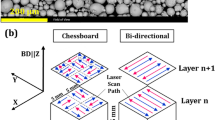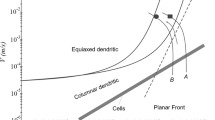Abstract
Fe-10Cu powders containing 20-nm grains were produced by attritor milling of elemental powders in argon. A rapid powder forging technique was developed to consolidate the powders into fully dense compacts while maintaining nanoscale grain sizes. Grain growth during the consolidation was controlled by reducing the time of exposure at elevated temperature to a few minutes or less, a technique which is applicable to all materials and does not necessitate the addition of dispersoids. This was achieved by heating green compacts quickly using an induction heater, and then forging and rapidly cooling them back to room temperature. Forging was conducted in a protective argon atmosphere to limit contamination. Fully dense compacts were produced at relatively low temperatures, mainly due to the accelerated creep rates exhibited by the nanostructures. Transmission electron microscopy and X-ray diffraction analysis found an average grain size of 45 nm in the fully dense samples forged at 530 °C. Indications are that finer grain sizes should be attainable by using slightly lower temperatures and higher pressures. The success of the technique (compared to hot-isostatic pressing (“hipping”)) is due to both reducing time at elevated temperatures and applying relatively high pressures. Microhardness tests revealed a significant strengthening effect due to grain size refinement, following a Hall-Petch relation. Compression testing at room temperature showed no strain hardening during plastic deformation, which occurred by shear banding. High strengths, up to 1800 MPa, were obtained at room temperature. Compression testing at 575 °C revealed a significant strain rate dependence of mechanical behavior and also the possibility of superplastic behavior. Power-law creep was observed at 575 °C, with very high steady-state creep rates on the order of 50 pct/s at 230 MPa. The consolidation process was successfully modeled by slightly modifying and applying the Arzt, Ashby, and Easterling (AAE) hot-isostatic press (HIP) model. The experiments and modeling indicated that creep was the dominant densification mechanism in these materials, even at relatively low temperatures and high loading rates. The results of this investigation suggest the possibility of a commercially viable nanostructured metal, which is easily processed to large strains at moderate temperatures, yet maintains high strength at room temperature without the necessity of heat treatment or mechanical working.
Similar content being viewed by others
References
H. Gleiter: Progr. Mater. Sci., 1989, vol. 33, pp. 223–315.
R.W. Siegel: NanoStr. Mater., 1993, vol. 3, pp. 1–18.
R. Birringer: Mater. Sci. Eng., 1989, vol. A117, pp. 33–43.
H. Gleiter: NanoStr. Mater., 1995, vol. 6, pp. 3–14.
C.C. Koch: in Materials Science and Technology, R.W. Cahn, P. Haasen, and E.J. Kramer, eds., VCH, Weinheim, 1991, vol. 15, pp. 193–245.
J. Eckert, J.C. Holzer, C.E. Krill III, and W.L. Johnson: J. Appl. Phys., 1993, vol. 73, pp. 2794–2802.
M. Jain and T. Christman: Acta Metall., 1994, vol. 42, pp. 1901–11.
M.A. Morris and D.G. Morris: Mater. Sci. Eng., 1989, vol. A111, pp. 115–27.
J.E. Carsley, W.W. Milligan, S.A. Hackney, and E.C. Aifantis: Metall. Mater. Trans. A, 1995, vol. 26A, pp. 2479–81.
L. He and E. Ma: J. Mater. Res., 1996, vol. 11, pp. 72–80.
L. He and E. Ma: NanoStr. Mater., 1996, vol. 7, pp. 327–39.
ASTM Standard C20-92, ASTM, Philadelphia, PA, 1996, vol. 15.01, pp. 5–7.
A. Guinier: X-Ray Diffraction in Crystals, Imperfect Crystals, and Amorphous Bodies, W.H. Freeman and Co., New York, NY, 1963, pp. 121 and 240–48.
B.E. Warren: X-Ray Diffraction, Addison-Wesley, Reading, MA, 1969, p. 251.
W.F. Hosford and R.M. Caddell: Metal Forming, Mechanics and Metallurgy, 2nd ed., PTR Prentice-Hall, Englewood Cliffs, NJ, 1993, pp. 122–29.
AISI Committee on Hot Rolled and Cold Finished Bar Products: Principles of Forging Design, American Iron and Steel Institute, New York, NY, 1965, pp. 10–11.
J. Eckert, J.C. Holzer, and W.L. Johnson: Scripta Metall., 1992, vol. 27, pp. 1105–10.
J. Eckert, J.C. Holzer, and W.L. Johnson: J. Appl. Phys., 1993, vol. 73, pp. 131–41.
R.A. Jago and N. Hansen: Acta Metall., 1986, vol. 34, pp. 1711–20.
J.E. Carsley, J. Ning, W.W. Milligan, S.A. Hackney, and E.C. Aifantis: NanoStr. Mater., 1995, vol. 5, pp. 441–48.
D. Tabor: The Hardness of Metals, Oxford University Press, London, 1951, p. 107.
J. Pilling and N. Ridley: Superplasticity in Crystalline Solids, The Institute of Metals, London, 1989, p. 4.
T.H. Courtney: Mechanical Behavior of Materials, McGraw-Hill, Inc., New York, NY, 1990, (a) p. 300 and (b) pp. 263–90.
H. Hahn, J. Logas, and R.S. Averback: J. Mater. Res., 1990, vol. 5, pp. 609–14.
M. Ke, S.A. Hackney, W.W. Milligan, and E.C. Aifantis: NanoStr. Mater., 1995, vol. 5, pp. 689–98.
S. Shima and M. Oyane: Int. Mech. Sci., 1976, vol. 18, pp. 285–91.
E. Artz, M.F. Ashby, and K.E. Esterling: Metall. Trans. A, 1983, vol. 14A, pp. 211–21.
A.S. Helle, K.E. Esterling, and M.F. Ashby: Acta Metall., 1985, vol. 33, pp. 2163–74.
D.S. Wilkinson and M.F. Ashby: Acta. Metall., 1975, vol. 23, pp. 1277–85.
S.J. Mashl: Ph.D. Thesis, Michigan Technological University, Houghton, MI, 1994.
H.A. Kuhn and C.A. Downey: Int. J. Powder Metall., 1971, vol. 7, pp. 15–25.
Computer program available at http://www.mm.mtu.edu/~milligan/research.
H.J. Frost and M.F. Ashby: Deformation-Mechanism Maps, Pergamon Press, Oxford, United Kingdom, 1982, (a) pp. 6–16, (b) p. 21, and (c) pp. 62–63.
Author information
Authors and Affiliations
Rights and permissions
About this article
Cite this article
Shaik, G.R., Milligan, W.W. Consolidation of nanostructured metal powders by rapid forging: Processing, modeling, and subsequent mechanical behavior. Metall Mater Trans A 28, 895–904 (1997). https://doi.org/10.1007/s11661-997-0077-7
Received:
Issue Date:
DOI: https://doi.org/10.1007/s11661-997-0077-7




